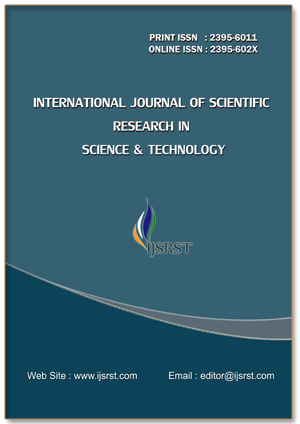The Interplay of Internet of Things (IoT) and Green Economy: A Bibliometric Analysis of Indian and Global Trends
DOI:
https://doi.org/10.32628/IJSRST2512422Keywords:
Internet of Things (IOT), Green Economy (GE), SCOPUS Database, Bibliometric Analysis, IndiaAbstract
Internet of Things (IoT) technologies offer an increasing role in green economies across the world through facilitating environmental conservation and responsible use of natural resources. IoT technologies offer prospects for addressing environmental issues such as pollution, water scarcity, and unsustainable urban expansion in India. This study uses systematic descriptive and bibliometric methods to analyse Scopus data to examine India's research development in the area of the linkage between the green economy and the Internet of Things (IoT). The findings suggest that China dominates the world in research collaborations and citation impact in the context of the nexus between IoT and the Green Economy topic, whereas India demonstrates a substantial research endeavour, yet it is not as per the current need. This underlines the necessity that India must increase IoT and green economy research to effectively leverage IoT technology to reduce environmental problems and improve environmentally supportive economic pathways for green economic growth.
📊 Article Downloads
References
https://www.6wresearch.com/industry-report/india-iot-market
Wang, S., Li, Q., & Zhang, X. (2020). Smart energy management through IoT: Opportunities and challenges. Energy Reports, 6, 1008–1022. https://doi.org/10.1016/j.egyr.2020.03.007
Khan, M. A., Jan, M. A., & Tahir, M. (2021). IoT-based energy management systems for environmental sustainability. Renewable and Sustainable Energy Reviews, 149, 111338. https://doi.org/10.1016/j.rser.2021.111338
Zorzi, M., & Gluhak, A. (2018). IoT-enabled waste management: Smart solutions for a greener environment. IEEE Internet of Things Journal, 5(5), 3719–3729. https://doi.org/10.1109/JIOT.2018.2850826
Raj, S., Sharma, V., & Kumar, R. (2021). IoT applications in industrial waste management. Environmental Technology & Innovation, 24, 101877. https://doi.org/10.1016/j.eti.2021.101877
Wang, Z., Qiao, X., Wang, Y., Yu, H., & Mu, C. (2024). IoT-based system of prevention and control for crop diseases and insect pests. Frontiers in Plant Sciences, 15, Article 1323074. https://doi.org/10.3389/fpls.2024.1323074
Gong, H., Zhang, Y., & Li, P. (2020). IoT applications in aquaculture: Environmental monitoring and management. Aquaculture Technology Journal, 12(3), 45-57.
Al-Turjman, F., Abujubbeh, M., & Malekloo, A. (2019). IoT and renewable energy systems: An overview. Journal of Cleaner Production, 244, 118805. https://doi.org/10.1016/j.jclepro.2019.118805
Ahmed, M., Khan, R., & Tariq, R. (2021). IoT-based smart city frameworks for green urban development. Sustainable Cities and Society, 64, 102521. https://doi.org/10.1016/j.scs.2020.102521
Chugh, R., Singh, K., & Naik, G. (2020). The dark side of IoT: Exploring its impact on the environment. Environmental Research and Technology, 4(2), 10–18.
Geissdoerfer, M., Savaget, P., Bocken, N. M. P., & Hultink, E. J. (2017). The Circular Economy–A new sustainability paradigm? Journal of Cleaner Production, 143, 757–768. https://doi.org/10.1016/j.jclepro.2016.12.048
Andrae, A. S. G., & Edler, T. (2015). On global electricity usage of communication technology: Trends to 2030. Challenges, 6(1), 117–157. https://doi.org/10.3390/challe6010117
Chaudhary, P., Sharma, P., & Singh, R. (2018). IoT-based precision agriculture and its impact on the environment: A review. Environmental Science & Technology, 52(15), 9027–9038.
Sharma, R., Gupta, P., & Kumar, S. (2021). IoT-based precision farming for sustainable agriculture in India. Sustainable Agriculture Reviews, 48, 221–239.
Sharma, A., & Gupta, S. (2020). IoT in renewable energy and energy efficiency: Challenges and prospects. Journal of Renewable and Sustainable Energy, 12(3), 1-15.
N. De Bellis (2009) Bibliometrics and citation analysis: from the science citation index to cybermetrics, scarecrow press (2009)
Block, J.H.; Fisch, C. (2020). Eight tips and questions for your bibliographic study in business and management research. Manag. Rev. Q 2020, 70, 307–312
Garza-Reyes, J. A. (2015). Lean and green-a systematic review of the state-of the art literature. Journal of Cleaner Production, vol. 102, pp. 18–29, 2015. https://doi.org/10.1016/j.jclepro.2015.04.064
Heersmink, R., van den Hoven, J., van Eck, N. J., van Berg, J. den.. (2011). Bibliometric mapping of computer and information ethics. Ethics and Information Technology, vol. 13, no. 3, pp. 241–249, 2011 https://doi.org/10.1007/s10676-011-9273-7
Donthu, N., Kumar, S., Mukherjee, D., Pandey, N., Lim, W.M. (2021). How to conduct a bibliometric analysis: An overview and guidelines. J. Bus. Res. 2021, 133, 285–296
Waltman L., van Eck N. J. (2015). Field-normalized citation impact indicators and the choice of an appropriate counting method. Journal of Informetrics, 9, 872–894
Ding Y., Cronin B. (2011). Popular and/or prestigious? Measures of scholarly esteem. Information Processing & Management, 47, 80–96
Caviggioli F., Ughetto E. (2019). A bibliometric analysis of the research dealing with the impact of additive manufacturing on industry, business and society. International Journal of Production Economics, 208, 254–268
Bui T. D., Ali M. H., Tsai F. M., Iranmanesh M., Tseng M. L., Lim M. K. (2020). Challenges and trends in sustainable corporate finance: A bibliometric systematic review. Journal of Risk and Financial Management, 13, 264
Downloads
Published
Issue
Section
License
Copyright (c) 2025 International Journal of Scientific Research in Science and Technology

This work is licensed under a Creative Commons Attribution 4.0 International License.
https://creativecommons.org/licenses/by/4.0




